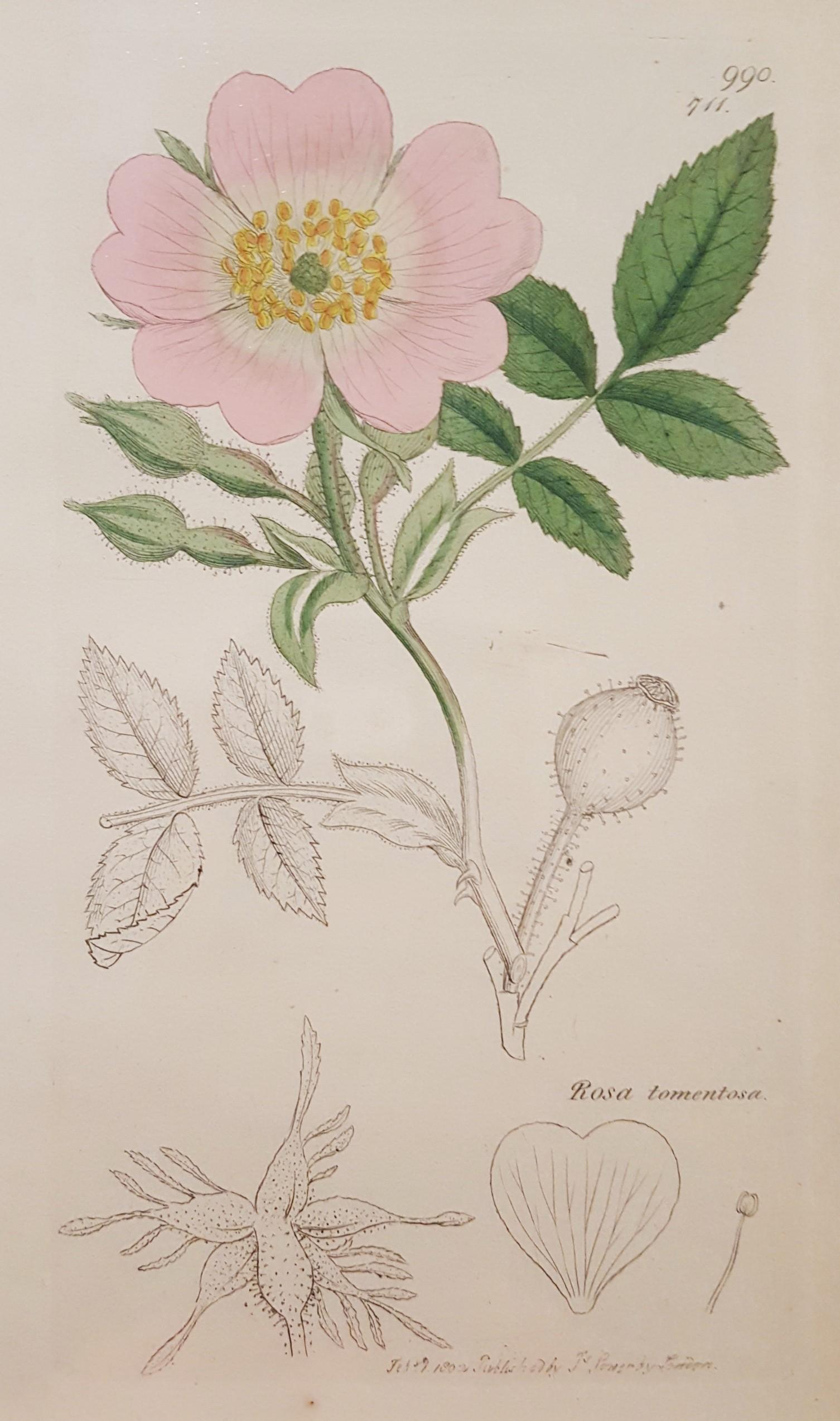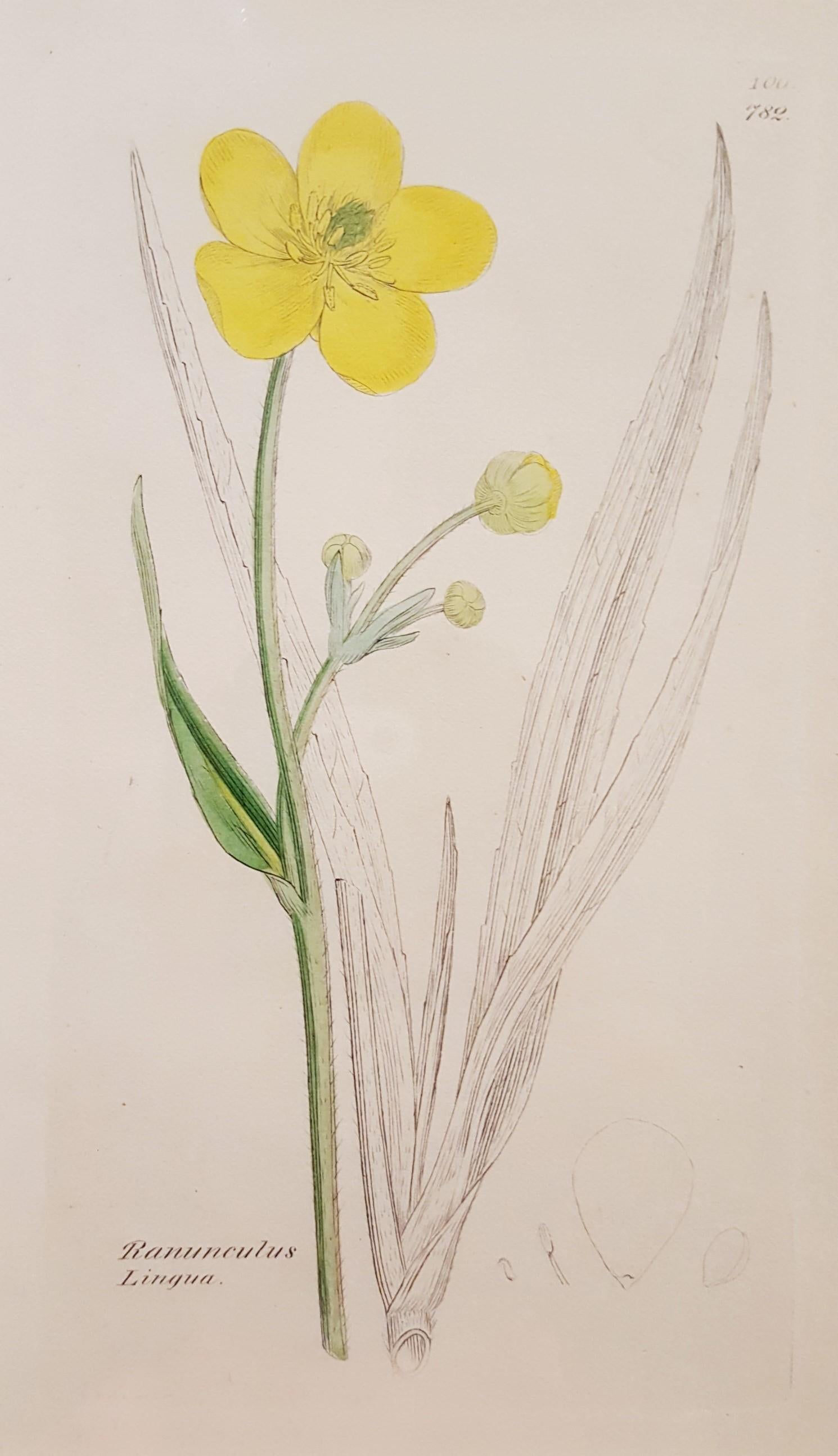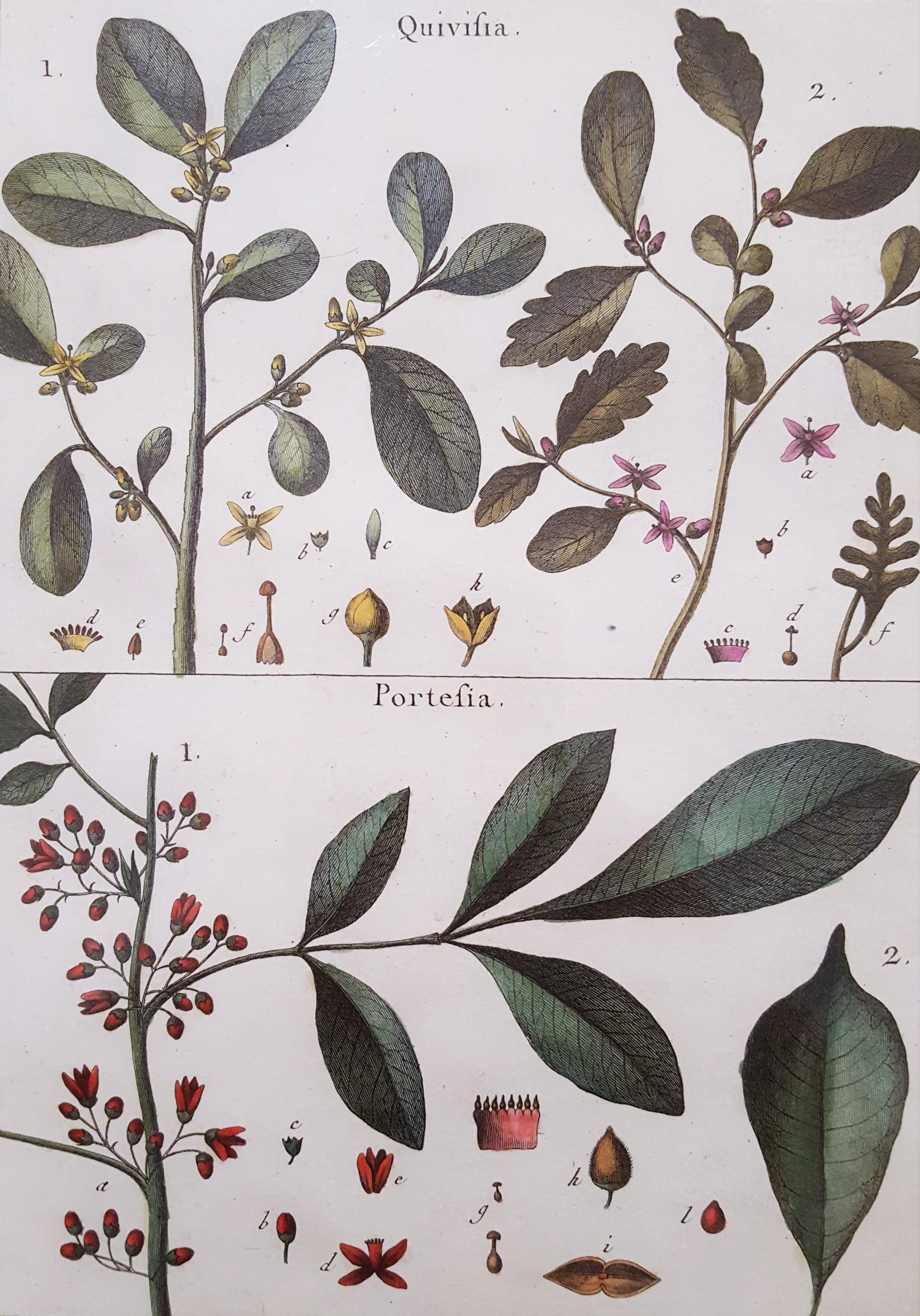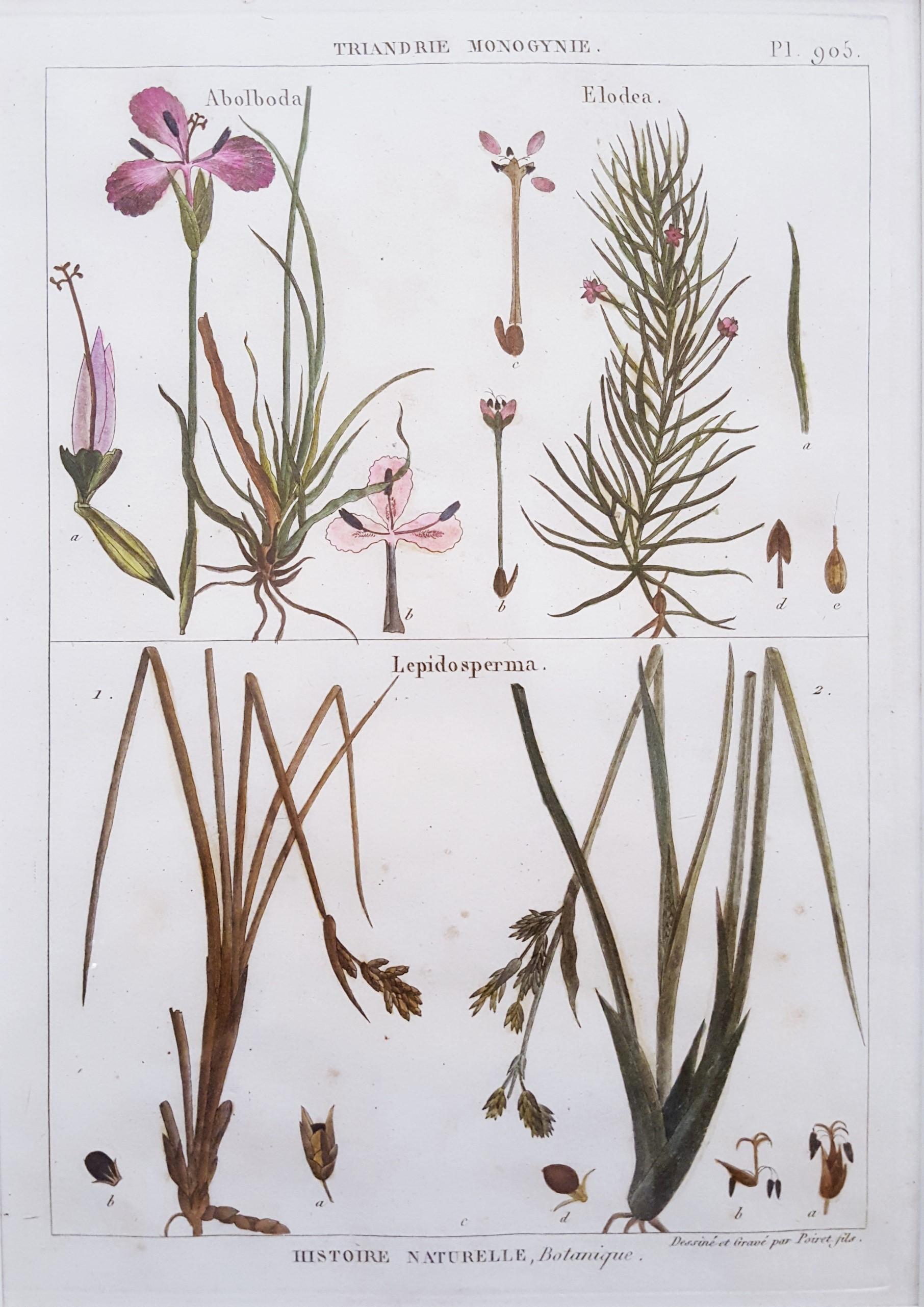Items Similar to Aquilegia Vulgaris (Common Columbine) /// Botanical Botany James Sowerby Flower
Want more images or videos?
Request additional images or videos from the seller
1 of 20
James SowerbyAquilegia Vulgaris (Common Columbine) /// Botanical Botany James Sowerby Flower1796
1796
About the Item
Artist: James Sowerby (English, 1757-1822)
Title: "Aquilegia Vulgaris (Common Columbine)" (Plate 297)
Portfolio: English Botany
Year: 1796
Medium: Original Hand-Colored Engraving on wove paper
Limited edition: Unknown
Printer: J. Davis, Richard and Arthur Taylor, London, UK
Publisher: James Sowerby, London, UK
Reference: Henrey No. 1366-1368; Hunt No. 717; Nissen BBI No. 2225-2226; Pritzel No. 8789-8791; Stafleu and Cowan No. 12221
Framing: Recently framed in a gold gilded, fluted moulding with 100% cotton rag matting from Holland. All archival
Framed size: 14.75" x 12"
Image size: 6.75" x 3.75"
Condition: Light toning to sheet. In excellent condition
Notes:
Comes from Sowerby's monumental thirty-seven volume, bound in thirty-six, portfolio "English Botany" or "Coloured Figures of British Plants" (1790-1814), which consists of 2,592 hand-colored engravings.
Aquilegia vulgaris is a species of columbine native to Europe. It is a flowering herbaceous perennial plant growing to 1.2 m tall, with branched, thinly hairy stems. The leaves are biternate; each leaf has three groups of three leaflets.
Biography:
James Sowerby (21 March 1757-25 October 1822) was an English naturalist, illustrator and mineralogist. Contributions to published works, such as A Specimen of the Botany of New Holland or English Botany, include his detailed and appealing plates. The use of vivid color and accessible texts were intended to reach a widening audience in works of natural history. The standard author abbreviation Sowerby is used to indicate this person as the author when citing a botanical name.
- Creator:James Sowerby (1730 - 1813, English)
- Creation Year:1796
- Dimensions:Height: 14.75 in (37.47 cm)Width: 12 in (30.48 cm)
- Medium:
- Movement & Style:
- Period:1790-1799
- Condition:
- Gallery Location:Saint Augustine, FL
- Reference Number:1stDibs: LU12126900752
About the Seller
5.0
Platinum Seller
These expertly vetted sellers are 1stDibs' most experienced sellers and are rated highest by our customers.
Established in 1978
1stDibs seller since 2015
1,214 sales on 1stDibs
Typical response time: <1 hour
- ShippingRetrieving quote...Ships From: Saint Augustine, FL
- Return PolicyA return for this item may be initiated within 3 days of delivery.
More From This SellerView All
- Rosa Tomentosa (Harsh Downy-rose) /// Botanical Botany James Sowerby Flower ArtBy James SowerbyLocated in Saint Augustine, FLArtist: James Sowerby (English, 1757-1822) Title: "Rosa Tomentosa (Harsh Downy-rose)" (Plate 990) Portfolio: English Botany Year: 1802 Medium: Original Hand-Colored Engraving on wove paper Limited edition: Unknown Printer: J. Davis, Richard and Arthur Taylor, London, UK Publisher: James Sowerby, London, UK Reference: Henrey No. 1366-1368; Hunt No. 717; Nissen BBI No. 2225-2226; Pritzel No. 8789-8791; Stafleu and Cowan No. 12221 Framing: Recently framed in a gold gilded, fluted moulding with 100% cotton rag matting from Holland. All archival Framed size: 14.75" x 12" Image size: 7.13" x 4.25" Condition: In excellent condition Notes: Comes from Sowerby's monumental thirty-seven volume, bound in thirty-six, portfolio "English Botany" or "Coloured Figures of British Plants" (1790-1814), which consists of 2,592 hand-colored engravings. Rosa tomentosa, otherwise known as the harsh downy-rose, is a species of plant in the family Rosaceae. It is native to the British Isles, where it is commonest in Wales and west and south-east England. It typically flowers between June and July and can be found in hedgerows and woodland margins. Biography: James Sowerby (21 March 1757-25 October 1822) was an English naturalist, illustrator and mineralogist. Contributions to published works, such as A Specimen of the Botany of New Holland...Category
Early 1800s Naturalistic Still-life Prints
MaterialsIntaglio, Watercolor, Engraving
- Ranunculus Lingua (Greater Spearwort) /// Botanical Botany James Sowerby FlowerBy James SowerbyLocated in Saint Augustine, FLArtist: James Sowerby (English, 1757-1822) Title: "Ranunculus Lingua (Greater Spearwort)" (Plate 100) Portfolio: English Botany Year: 1793 Medium: Original Hand-Colored Engraving on ...Category
Early 1800s Naturalistic Still-life Prints
MaterialsIntaglio, Engraving, Watercolor
- Quivisia; Portesia /// Antique Botanical Botany Plants Science Engraving BuffonBy Georges-Louis Leclerc, Comte de BuffonLocated in Saint Augustine, FLArtist: Georges-Louis Leclerc, Comte de Buffon (French, 1707-1788) Title: "Quivisia; Portesia" (Octandreie, Monogynie, Plate 302) Portfolio: Histoire Naturelle Year: 1749-1789 Medium: Original Hand-Colored Engraving on laid paper Limited edition: Unknown Printer: Imprimerie Nationale, Paris, France Publisher: Georges-Louis Leclerc, Comte de Buffon, Paris, France Framing: Not framed, but beautifully double matted with hand decorated archival French matting...Category
2010s Naturalistic Still-life Prints
MaterialsWatercolor, Engraving, Laid Paper, Intaglio
- Atraphaxis (Shrub); Cabomba (Carolina Fanwort) /// Botanical Botany Plants ArtBy Georges-Louis Leclerc, Comte de BuffonLocated in Saint Augustine, FLArtist: Georges-Louis Leclerc, Comte de Buffon (French, 1707-1788) Title: "Atraphaxis (Shrub); Cabomba (Carolina Fanwort)" (Hexandrie, Digynie, Plate 265) Portfolio: Histoire Naturel...Category
1740s Naturalistic Still-life Prints
MaterialsWatercolor, Engraving, Laid Paper, Intaglio
- Abolboda; Elodea (Waterweeds); Lepidosperma (Hoary Rapier-Sedge) /// BotanicalBy Georges-Louis Leclerc, Comte de BuffonLocated in Saint Augustine, FLArtist: Georges-Louis Leclerc, Comte de Buffon (French, 1707-1788) Title: "Abolboda; Elodea (Waterweeds); Lepidosperma (Hoary Rapier-Sedge)" (Triandrie Monogynie, Plate 905) Portfoli...Category
1740s Naturalistic Still-life Prints
MaterialsWatercolor, Engraving, Laid Paper, Intaglio
- Euphorbia (Spurge) /// Antique Botanical Botany Plants Engraving Buffon ScienceBy Georges-Louis Leclerc, Comte de BuffonLocated in Saint Augustine, FLArtist: Georges-Louis Leclerc, Comte de Buffon (French, 1707-1788) Title: "Euphorbia (Spurge)" (Dodecandrie, Trigynie, Plate 411) Portfolio: Histoire Naturelle Year: 1749-1789 Medium...Category
1740s Naturalistic Still-life Prints
MaterialsWatercolor, Engraving, Laid Paper, Intaglio
You May Also Like
- 4 plates from The Wondrous Transformation of Caterpillars & their Strange Diet..By Maria Sibylla MerianLocated in Middletown, NYFour plates from The Wondrous Transformation of Caterpillars and their Strange Diet of Flowers. “Wolfsmelk Rupsen;" “Wolfsmilch, Raupe und Schmetterling" Amsterdam: J F Bernard, 1730. Each an engraving with hand coloring in watercolor and gouache printed on one sheet of watermarked Honig cream laid paper, each measures 6 1/4 x 5 inches (157 x 121 mm), sheet measures 20 5/8 x 14 inches (522 x 355 mm), full margins. With handling creases in the lower right sheet quadrant, as well as minor, loose cockling, otherwise in very good condition. The colors are superb with exceptionally fresh and bright saturation. Engraved between 1679 and 1683, printed 1730. Plates included: No.1:I; No. 2:1; II & III. MARIA SIBYLLA MERIAN was one of the most highly respected entomologists of the 17th century, and remains today one of the field's most significant figures. A German-born naturalist and scientific illustrator, she reared herself on the study of caterpillars, and made tremendous contributions to the knowledge of the life cycles of numerous species. Until her detailed and careful study of the process of metamorphosis it was thought that insects were "born of mud," through spontaneous generation. Trained as a miniature painter by her stepfather, she published her first book of illustrations in 1675, at the age of 28. In 1679, Merian published the first volume of the two-volume series on caterpillars, The Wondrous Transformation of Caterpillars and their Strange Diet of Flowers; the second volume followed in 1683. Each volume contained 50 plates that she engraved and etched. In 1699, Merian traveled to Dutch Guiana...Category
Early 18th Century Naturalistic Still-life Prints
MaterialsWatercolor, Engraving
- POITEAU/TURPIN. Traité des arbres fruitiers: A Set of Four ApplesBy POITEAU, A. and P. TURPIN.Located in London, GBPOITEAU, A. and P. TURPIN. Traité des arbres fruitiers: A Set of Four Apples H. Perronneau for T. Delachausée, Paris, 1807-1835. A set of Four Apples, fine stipple-engrave...Category
Early 1800s Naturalistic Still-life Prints
MaterialsHandmade Paper, Engraving, Watercolor
- Thistle and Moths, plate no. 6, Metamorphosis Insectorum SurinamensiumBy Maria Sibylla MerianLocated in Middletown, NYMetamorphosis Insectorum Surinamensium, Plate No. 6; Thistle and Moths. The Netherlands: 1705. Engraving with hand coloring in w...Category
Early 18th Century Naturalistic Still-life Prints
MaterialsWatercolor, Engraving
- 4 plates from The Wondrous Transformation of Caterpillars & their Strange Diet..By Maria Sibylla MerianLocated in Middletown, NYFour plates from The Wondrous Transformation of Caterpillars and their Strange Diet of Flowers. “Wolfsmelk Rupsen;" “Wolfsmilch, Raupe und Schmetterling" Amsterdam: J F Bernard, 1730. Each an engraving with hand coloring in watercolor and gouache printed on one sheet of watermarked Honig cream laid paper, each measures 6 1/4 x 5 inches (157 x 121 mm), sheet measures 20 5/8 x 14 inches (522 x 355 mm), full margins. With one 1.5 inch inch tear across the area of the top-left corner, well outside of image area. Handling creases in the lower right sheet quadrant, as well as minor, loose cockling, otherwise in very good condition. The colors are superb with exceptionally fresh and bright saturation. Engraved between 1679 and 1683, printed 1730. Plates included: CXXI, CXXII, CXXIII, & CXXIV. MARIA SIBYLLA MERIAN was one of the most highly respected entomologists of the 17th century, and remains today one of the field's most significant figures. A German-born naturalist and scientific illustrator, she reared herself on the study of caterpillars, and made tremendous contributions to the knowledge of the life cycles of numerous species. Until her detailed and careful study of the process of metamorphosis it was thought that insects were "born of mud," through spontaneous generation. Trained as a miniature painter by her stepfather, she published her first book of illustrations in 1675, at the age of 28. In 1679, Merian published the first volume of the two-volume series on caterpillars, The Wondrous Transformation of Caterpillars and their Strange Diet of Flowers; the second volume followed in 1683. Each volume contained 50 plates that she engraved and etched. In 1699, Merian traveled to Dutch Guiana...Category
Early 18th Century Naturalistic Still-life Prints
MaterialsWatercolor, Engraving
- Cocoa plant, caterpillar, ..., Plate 26, Metamorphosis Insectorum SurinamensiumBy Maria Sibylla MerianLocated in Middletown, NYMetamorphosis Insectorum Surinamensium, Plate No. 26; Cocoa plant, caterpillar, pupa, and butterflies. The Netherlands: 1705. En...Category
Early 18th Century Naturalistic Still-life Prints
MaterialsWatercolor, Engraving
- 4 plates from The Wondrous Transformation of Caterpillars & their Strange Diet..By Maria Sibylla MerianLocated in Middletown, NYFour plates from The Wondrous Transformation of Caterpillars and their Strange Diet of Flowers. “Wolfsmelk Rupsen;" “Wolfsmilch, Raupe und Schmetterling" Amsterdam: J F Bernard, 1730. Each an engraving with hand coloring in watercolor and gouache printed on one sheet of watermarked Honig cream laid paper, each measures 6 1/4 x 5 inches (157 x 121 mm), sheet measures 20 5/8 x 14 inches (522 x 355 mm), full margins. With handling creases in the lower right sheet quadrant, as well as minor, loose cockling, otherwise in very good condition. The colors are superb with exceptionally fresh and bright saturation. Engraved between 1679 and 1683, printed 1730. Plates included: LIV, LV, LVI, & LVII. MARIA SIBYLLA MERIAN was one of the most highly respected entomologists of the 17th century, and remains today one of the field's most significant figures. A German-born naturalist and scientific illustrator, she reared herself on the study of caterpillars, and made tremendous contributions to the knowledge of the life cycles of numerous species. Until her detailed and careful study of the process of metamorphosis it was thought that insects were "born of mud," through spontaneous generation. Trained as a miniature painter by her stepfather, she published her first book of illustrations in 1675, at the age of 28. In 1679, Merian published the first volume of the two-volume series on caterpillars, The Wondrous Transformation of Caterpillars and their Strange Diet of Flowers; the second volume followed in 1683. Each volume contained 50 plates that she engraved and etched. In 1699, Merian traveled to Dutch Guiana...Category
Early 18th Century Naturalistic Still-life Prints
MaterialsWatercolor, Engraving
Recently Viewed
View AllMore Ways To Browse
Common Plate
Antique Copper Colour
Antique Copper Color
Gilded Copper
Antique Copper Still
Antique Copper Stills
Copper Still Antique
Antique Light Plant
Antique Plates Uk
Tall Thin Art
Botanical Gold Leaf
Framed Botanical Prints And Engravings
Botanical Specimen Framed
Gold Framed Botanical Prints
Native Flute
18th Century Oil On Canvas
1973 Sculptures
1973 Sculpture





